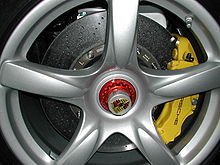Carbon ceramic
In carbon-ceramic is one with carbon fiber -reinforced ceramic silicon carbide - composite .
A more correct material name would be carbon fiber reinforced silicon carbide or C fiber reinforced SiC or, as it is introduced into the class of composite ceramics , C / SiC for short .
application
For the most part, carbon ceramics are used for brake pads and brake discs in luxury and sports cars. Factors such as durability and efficiency play a major role.
In addition, the material plays a role in developments in space travel as a replacement for the ceramic tiles or ablative systems currently in use, which protect the landing capsules of spaceships such as Soyuz or space shuttles such as the space shuttle from the heat when they re-enter the earth's atmosphere. The weight savings, the resistance to thermal shock loads and the potential multiple use are of great interest here. Most of the ablative systems used are combinations of materials that burn off in a controlled manner when re-entered due to the heat and are not reusable.
Use in braking systems for automobiles
advantages

The carbon-ceramic brake pads or brake discs achieve high and constant coefficients of friction , regardless of surface moisture and temperature, which means there is no fading effect . They last a very long time, with normal driving for the life of the car (manufacturers mention up to 300,000 km). Thanks to the corrosion resistance of the material (no salt corrosion in winter), the service life of the brake disc is extended.
They are also up to 70% lighter than conventional brake discs. This reduces the weight of the chassis and means a reduction in the unsprung masses with an improvement in the road contact between the wheels. Furthermore, carbon-ceramic offers a very low density combined with high specific strength, whereby the absolute strength values of this ceramic are lower than those of steel.
disadvantage
Carbon ceramics currently have significantly higher production costs than the conventionally used metals. One of the reasons for this is that defective discs cannot be melted down, as is the case with a cast brake disc. For this reason, brake discs made from this material are currently only available for high-end sports and luxury vehicles; It remains to be seen whether windows made of this material will become established in mid-range vehicles.
Due to their low weight, the use of simple ceramic brake discs without sophisticated internal ventilation is quite possible in light vehicles with high innovation potential (for example in purely electric vehicles).
When subjected to heavy loads, ceramic discs also start to glow similar to conventional brake discs. Since they can withstand much higher temperatures (1300 ° C) than metallic disks, the immediate vicinity of such brake disks must be prepared for this temperature level, which is ensured by the brake system manufacturers through design measures.
Web links
- Carbon and Ceramic Technologies (accessed August 7, 2020)
- Novel manufacturing process for carbon fiber reinforced silicon carbide with fiber-dominated behavior (accessed on August 7, 2020)
- Machining of lightweight materials (accessed on August 7, 2020)
- Contribution to the development of novel hybrid material composites based on polymer / ceramic (accessed on August 7, 2020)
- Carbon fiber reinforced carbon: fiber matrix connection and its influence on the short fiber composite (accessed on August 7, 2020)